Industry Report
Veeva Digital Clinical Trials Survey Report
COVID-19 accelerated the adoption of new decentralized clinical trial operating models and revealed the need to make studies more patient- and site-centric. The industry is now maturing practices adopted during the pandemic into a more digital, connected model for clinical trials in the future.
This survey report details insights from more than 280 clinical leaders worldwide on the industry’s progress toward digital trial strategies, lessons learned, and what lies ahead.
Executive Summary
Survey results show that the industry is accelerating digital transformation to advance toward patient-centric, paperless, and decentralized trials.
Most sponsors and CROs are addressing the challenges posed by point solutions and manual processes and moving to a more connected digital trial operating model. This shift will automate the flow of information across patients, sites, sponsors, and CROs to create a fully connected and collaborative trial ecosystem.
Benefits and Challenges of Decentralized Trials
- During the pandemic, 87% of sponsors and CROs surveyed rapidly deployed decentralized trials to manage clinical studies (compared with 28% pre-COVID). They adopted an average of four new eClinical applications, leading to challenges with data and system silos.
- Despite progress, fragmented technology has created additional challenges in site adoption, patient burden, and data collection and reporting, diminishing potential gains in study speed, quality, and collaboration.
- Only 56% say the move to decentralized trials has improved the patient experience, and less than a third have seen improved site engagement, reduced costs, and shortened trial timelines.
What’s Next?
- Sponsors and CROs are rationalizing systems and processes deployed during the pandemic for a more holistic approach that better connects stakeholders, improves study quality, and accelerates clinical research.
- To enable this connected approach, most respondents (95%) are establishing a unified digital foundation to better support sites and patients, and improve data sharing and collaboration.
Rapid Adoption of Trial Decentralization Models
Most sponsors and CROs (87%) rapidly deployed decentralized trial approaches to minimize disruption, up 59 percentage points from 28% before the pandemic.
Within the next 24 months, 95% of respondents plan to increase their use of decentralized trials.
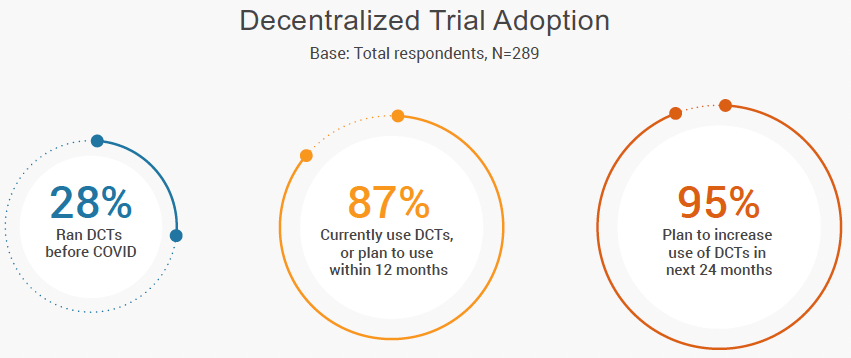
To your knowledge, was your organization conducting decentralized / hybrid trials prior to COVID? (Q4)
How likely is it that your organization will increase its adoption of decentralized / hybrid trials in the next two years? (Q5)
CROs provide the backbone of clinical trial services for sponsors, and they currently lead in adoption of digital trial technologies, particularly remote monitoring, eSource, eCOA/ePRO, and eConsent. The biggest differences in more than 20 percentage points were seen in eSource and eISF/eReg, likely due to the importance of data quality and site efficiency in driving speed and cost advantages.
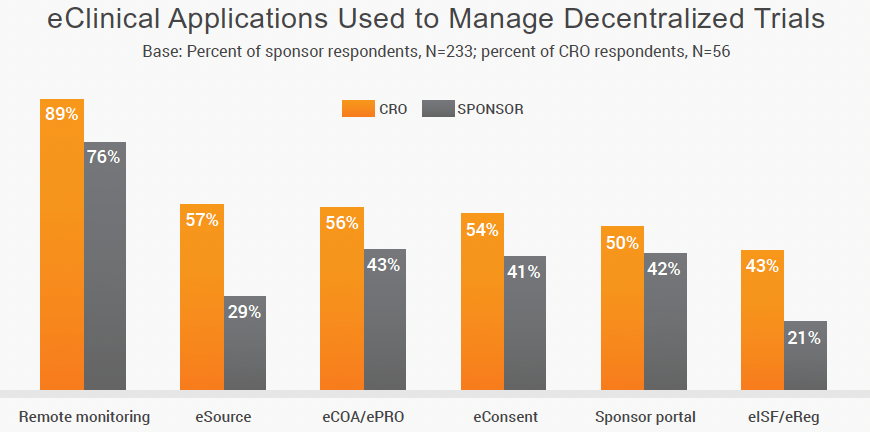
Select one box per row. (Q7)
Despite progress in moving to more digital ways of working, respondents described a fragmented technology landscape that is made even more challenging by the adoption of multiple point solutions:1
"All of these new solutions bring additional burden for time, cost, and quality.""New systems and processes have led to inefficient internal workflows, challenges with collaboration, and getting information in and out of systems."
Investment in emerging digital trial technologies will continue, as 32% say they plan to adopt eReg / eISF for their sites within the next 12 months, followed by eConsent (31%), and eSource (27%).
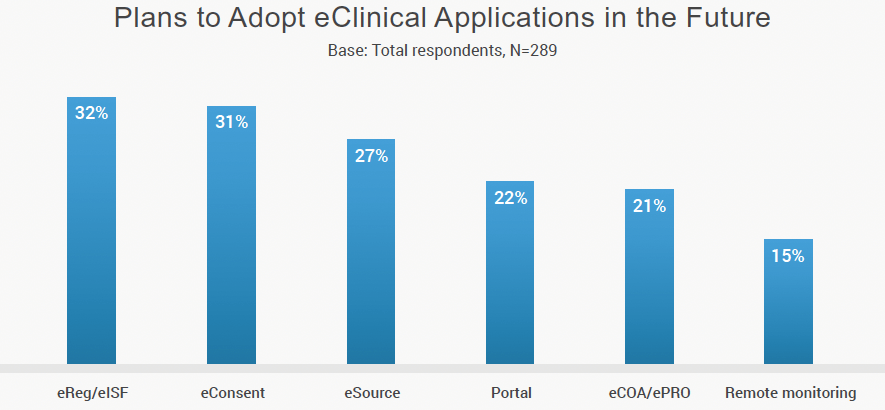
Select one box per row. (Q7)
Barriers to Patient-Centric Trials and Better Site Support
While sponsors and CROs move closer to achieving patient centricity, they are also improving engagement with clinical research sites and establishing interoperability across systems and processes.
Only 56% of sponsors and CROs report that decentralization has had a positive impact on patient convenience and retention, and less than a third (29%) report benefits with site engagement, reduced costs (29%), and shortened trial timelines (26%).
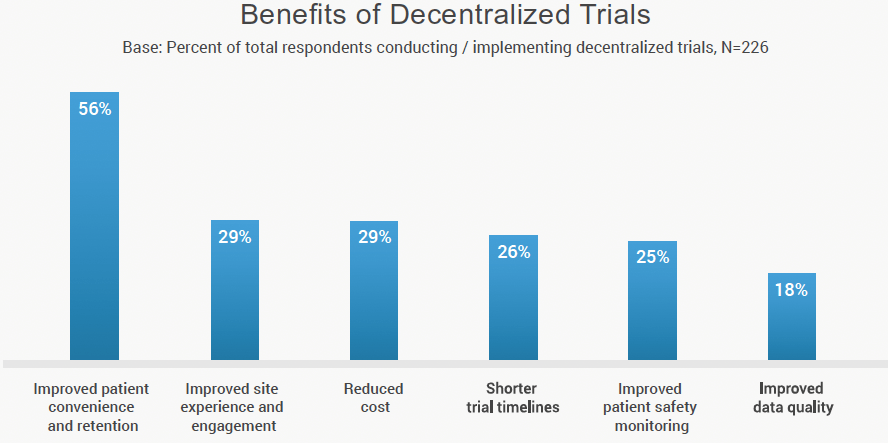
Nearly all sponsors and CROs (99%) report significant challenges with decentralized trials. The top challenge – site technology adoption (70%) – may reflect the complexity of managing multiple platforms to support different studies,2 lack of solutions that meet site operational needs,3 and sites’ insufficient expertise or budgets to implement new remote technologies.4
Over half of sponsors and CROS (59%) report issues with internal change management and stakeholder alignment, which may reflect organizational and technology challenges.5
Patient convenience is increasingly critical to patient enrollment and retention. However, in decentralized trials, the use of multiple patient-facing applications, such as eConsent, ePRO, patient concierge services, and telemedicine adds to study complexity for patients.6
As a result, half of sponsors and CROs surveyed see decentralized trial methods as increasing demands on patients who are technology averse.
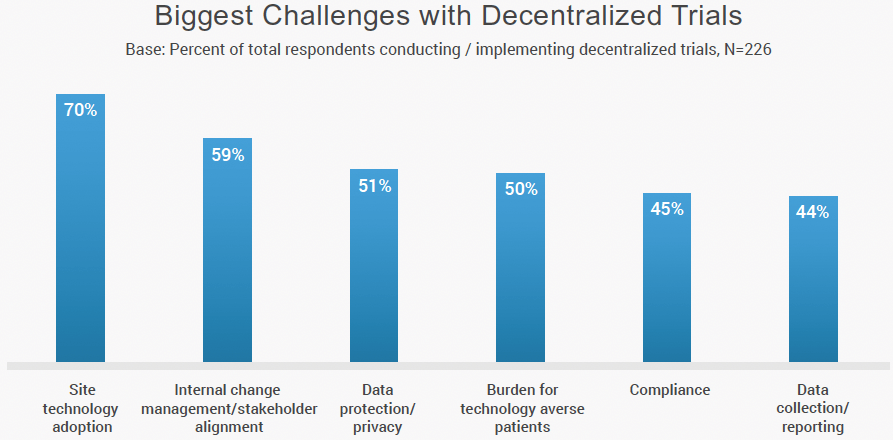
Advancing the Move to Digital Trials
Survey results show that the industry is shifting toward a more patient- and site-centric paradigm for clinical trials that better connects stakeholders, improves study quality, and accelerates clinical research.
Nearly all respondents (95%) have initiatives in place to address the systemic and operational challenges that were introduced by the rapid adoption of decentralized approaches.
Highlighting the critical importance of reducing site burden, most CROs (66%) and sponsors (53%) are making site technology a priority. They go on to note:
"Sites are burdened by too many technologies; we need to make it simpler for them… and use fewer technologies.""Decentralized trials introduce more technology, processes, and burden for the site. We need to provide a helping hand, a white glove approach to help them with efficient execution.""Invest earlier in physician and site coordinator training…and do not overburden the site."
Improving data sharing and collaboration is another key focus for CROs (54%) and sponsors (38%), as the industry works to move from manual methods such as emails and portals to exchange trial information.
CROs outpace sponsor companies in the adoption of eClinical applications, and they are more likely than sponsors to have measures in place to address the system interoperability problems caused by fragmented technologies. The survey found that 54% of CRO respondents versus 29% of those from sponsors, were actively addressing these challenges.
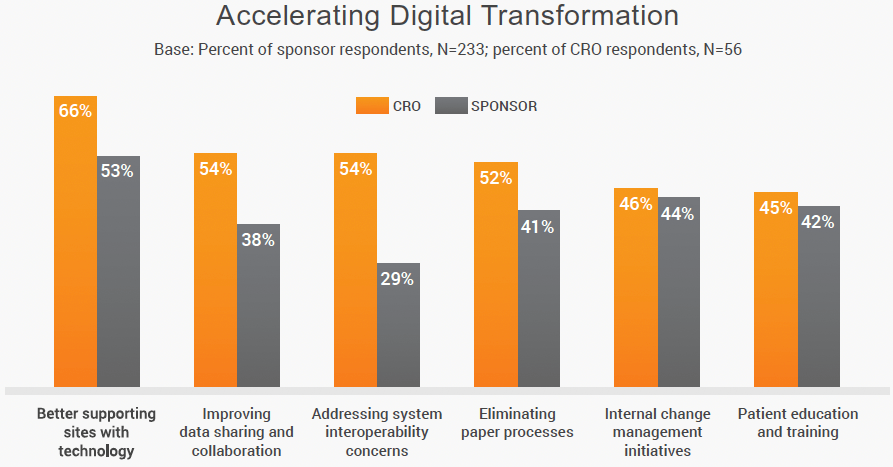
Select all that apply. (Q9)
Sponsors and CROs suggested ways to convert siloed systems and processes into a comprehensive digital trial strategy:
"It is essential to evaluate the relative merits of technologies but aim to use fewer applications with better connections between them.""Take a slower approach to incorporating and integrating new technologies.""Critically evaluate solutions that optimize the sponsor, investigator, and patient experience."
Conclusion
Sponsors and CROs view the digital transformation of clinical trials as a top priority as the industry accelerates its move toward patient-centric, decentralized, and paperless trials.
Decentralized approaches have driven positive change so far, but more work is needed to address the system and operational challenges that prevent faster, more cost-effective trials.
As the industry adopts a digital trial operating model to address this critical need, this research underscores the importance of:
- Improving the patient experience: There is a tremendous opportunity to improve patient enrollment and retention by making trial participation more accessible and convenient. Innovative patient-facing applications significantly enhance the patient experience by keeping them informed and connected through a single application for all their trial activities. Study information flows seamlessly between sponsors, CROs, sites, and patients, eliminating paper and manual processes, and increasing patient engagement.
- Adopting a site-focused approach to technology: To reduce administrative burden, sites are shifting towards more digital, connected ways of working by adopting site-centric technology. These fit-for-purpose site solutions enable investigators to streamline their operations, collaborate more easily with sponsors and CROs, and focus more on the work of treating patients. With modern technology, these sitecentric systems ensure that sites own and control their systems and the data and documentation stored within them.
- Unified digital platforms for a connected trial ecosystem: Positive change is underway as the industry progresses toward a digital trial environment that connects patients, sites, sponsors, and CROs to drive seamless execution and flow of data across stakeholders. Rationalizing systems, eliminating silos and manual processes, and having best-in-class applications on a modern digital trial platform is critical to a fully connected and collaborative trial ecosystem.
A holistic end-to-end digital framework for clinical trials promises to meet the diverse needs of patients, sites, sponsors, and CROs, strengthening connections between them, and reducing trial costs and timelines. As the industry progresses toward this vision, clinical trials will become more innovative, better serve patients, and speed their access to medical breakthroughs.
Survey Methods
The survey consisted of nine questions designed for individuals with knowledge of clinical processes and with partial or full responsibility for clinical research and/or clinical development activities within their organization. The survey was conducted by Veeva and promoted by Applied Clinical Trials, Questex, FirstWord, Clinical Leader, and LinkedIn. Completion of the survey was voluntary. Respondents received $20 Amazon gift card and were offered a summary of results. No other compensation was offered.
Survey Respondents
Of the approximately 15,000 individuals invited to take the survey, a total of 2,185 surveys were initiated, the majority of which were terminated based on a qualification question gauging the level of responsibility for clinical in their organization. More than 1,897 incomplete or unverified responses were eliminated, yielding 289 qualified responses.
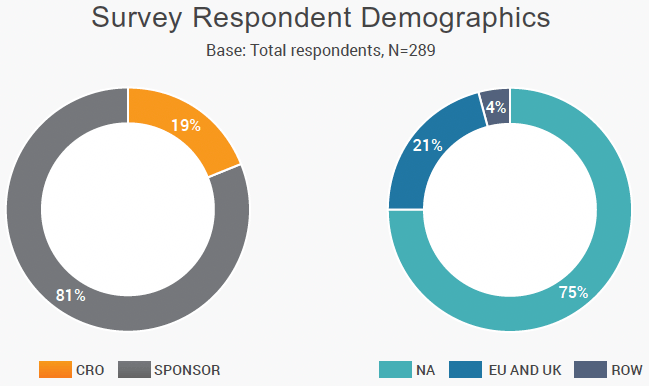
2 Agrawal Gaurav, Moss Rachel, Raschke Ralf, Wurzer Stephen, Xue John. No Place Like Home? Stepping Up the Decentralization of Clinical Trials. Mckinsey’s Pharmaceuticals & Medical Products Practice. 2021
3 Carozza Diane. Tool or Blugeon: Technology Can Support Clinical Trial Sites or Undermine Them. How Are You Using It? Clinical Researcher, March 10, 2020
4,5 Le Breton Stephen, Lamberti Mary Jo, Dion Adam, Getz Kenneth A. Covid-19, and Its Impact on the Future of Clinical Trial Execution. Applied Clinical Trials. October 22, 2020
6 Digitizing Clinical Trials. NPJ. Digital Medicine. July 31, 2020